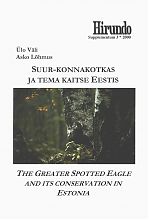Supplementum 3/2000
Ülo Väli & Asko Lõhmus
The Greater Spotted Eagle and its conservation in Estonia
Abstract
The publication is based on the Estonian national management plan for the Greater Spotted Eagle (Aquila clanga Pall.) in 2000-2004. We summarise the status, biology and threat factors of the species in Estonia and in the world, and propose a conservation strategy and needed actions for Estonia.
The Greater Spotted Eagle is a globally threatened species with the world population of less than 3,000 pairs. The 20-30 pairs that breed in Estonia are of European importance. The nests in Estonia are situated in old wet deciduous forests, often near waterbodies. In recent years, meadows have been the main feeding habitat, and small mammals have made up 74% of prey numbers. The productivity was good – 0.60 young per breeding territory annually, although the species seems to interbreed regularly with the Lesser Spotted Eagle (Aquila pomarina Brehm).
The main threats to the Greater Spotted Eagle in Estonia, as in Europe as a whole, are habitat loss and degradation as well as human disturbance during the breeding season. Requirements for the protection of the eagle’s nest sites are given.
For conservation management twenty-one activities are proposed. For example, the legal status of the species is not in accordance with its extremely strict protection status internationally. Therefore, the Greater Spotted Eagle should be included in the highest protection category also in Estonia. The priority actions for habitat conservation are establishing sanctuaries on nest sites, sending conservation obligations to land-owners and general conservation of old swamp forests. There should be efficient control over the fulfilment of nest site conservation requirements, and account on the sites of conservation concern. As there is still little information on the status of the species and most nest sites remain unknown, searching for new nests as well as monitoring numbers and productivity are essential. A leaflet about spotted eagles and their conservation should be the first step in rising public awareness.

